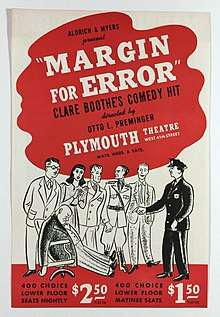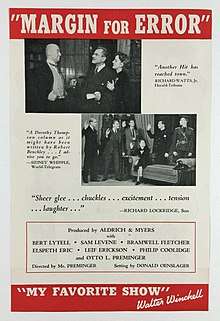Margin for Error (play)
Margin for Error is a two-act play written in 1939 by Clare Boothe Luce. It is a satire of Nazism, and was staged on Broadway shortly after World War II began in Europe. The plot is a whodunit about the murder of a German consul in the United States. The play was adapted as a movie of the same name in 1943.
| Margin for Error | |
|---|---|
 Flyer for the Broadway production | |
| Written by | Clare Boothe Luce |
| Date premiered | November 3, 1939 |
| Place premiered | Plymouth Theatre |
| Original language | English |
| Genre | Satire |
History
Otto Preminger directed and starred as the German consul in the Broadway production. After a preview in Princeton, New Jersey in October,[1] the play opened on November 3, 1939, at the Plymouth Theatre, where it ran for 264 performances.[2] Preminger reprised the role for a national tour in the summer of 1940.[3]
Plot
Officer Finkelstein, a Jewish policeman, is assigned to protect Karl Baumer, the consul for Nazi Germany in an American city. While hosting a group of people listening to a radio broadcast of a speech by Adolf Hitler, Baumer is apparently murdered. Finkelstein's investigation discovers that each of the others present has a motive for murdering Baumer. Dr. Jennings paid to get relatives out of Germany, only to discover Baumer has cheated him. Sophie Baumer hated her husband's cruelty and amorality. Baumer threatened to expose the Jewish ancestry of Baron Max von Alvenstor, and planned to kill Otto Horst. Thomas Denny, an American journalist, hates Baumer's Nazi ideology. All the suspects are found to be innocent; Baumer accidentally drank poison that he had prepared to murder one of his guests.[4]

Cast and characters
The characters and cast from the Broadway production are given below:[5]
| Character | Broadway cast |
|---|---|
| Otto B. Horst | Philip Coolidge |
| Baron Max von Alvenstor | Bramwell Fletcher |
| Officer Finkelstein | Sam Levene |
| Frieda | Evelyn Wahle |
| Dr. Jennings | Bert Lytell |
| Sophie Baumer | Elspeth Eric |
| Karl Baumer | Otto Preminger |
| Thomas S. Denny | Leif Erickson |
| Captain Mulrooney | Edward J. McNamara |
Adaptations
20th Century Fox purchased the screen rights for approximately $25,000 in the spring of 1941.[6] The studio shelved the project for about a year, but William Goetz, serving as interim studio head while Darryl F. Zanuck was fulfilling his military duty, greenlighted the project in April 1942.[7] Ernst Lubitsch was initially assigned to direct. Goetz wanted Preminger to reprise his role of Baumer, but Preminger insisted he wanted to direct as well. Preminger convinced Goetz by offering to direct for free and to withdraw from directing (but remain as Baumer) if Goetz was unhappy with his work at the end of the first week of filming.[8] Preminger hired Samuel Fuller to rewrite the script. The film was released in 1943, with comedian Milton Berle as Finkelstein. Preminger did play Baumer, and Edward McNamara also reprised the role of Mulrooney.[9]
References
- "Margin for Error Opens". The New York Times. October 15, 1939. p. 48.
- "Margin for Error". Internet Broadway Database. Retrieved November 18, 2019.
- Hirsch 2007, p. 81.
- Nannes 1960, pp. 135-137.
- Atkinson, Brooks (November 4, 1939). "The Play: Clare Boothe Ambushes a German Consulate in the Melodramatic Margin for Error". The New York Times. p. 11.
- "The Story of News Bought by Serlin". The New York Times. April 22, 1941. p. 26.
- "Margin for Error (1943)". TCM Movie Database. Turner Classic Movies. Retrieved November 18, 2019.
- Hirsch 2007, pp. 85-86.
- Hare 2003, p. 108.
Works cited
- Hare, William (2003). Early Film Noir: Greed, Lust and Murder Hollywood Style. Jefferson, North Carolina: McFarland. ISBN 0-7864-1629-7.CS1 maint: ref=harv (link)
- Hirsch, Foster (2007). Otto Preminger: The Man Who Would Be King. New York: Alfred A. Knopf. ISBN 978-0-375-41373-5.CS1 maint: ref=harv (link)
- Nannes, Caspar H. (1960). Politics in the American Drama. Washington, DC: Catholic University of America Press.CS1 maint: ref=harv (link)